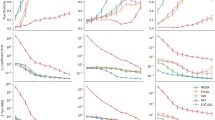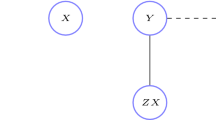Abstract
An underdetermined linear algebraic equation system \(\mathbf{y}={\varvec{\Phi }}\mathbf{x}\), where \({\varvec{\Phi }}\) is an \(m\times n (m<n)\) rectangular constant matrix with rank \(r\le m\) and \(\mathbf{y}\in \mathrm {Ran}({\varvec{\Phi }})\) (range of \({\varvec{\Phi }})\), has an infinite number of solutions. Diffeomorphic modulation under observable response preserving homotopy (D-MORPH) regression seeks a solution satisfying the extra requirement of minimizing a chosen cost function, \({\mathcal {K}}\). A wide variety of choices of the cost function makes it possible to achieve diverse goals, and hence D-MORPH regression has been successfully applied to solve a range of problems. In this paper, D-MORPH regression is extended to determine a sparse or a nonnegative sparse solution of the vector \(\mathbf{x}\). For this purpose, recursive reweighted least-squares (RRLS) minimization is adopted and modified to construct the cost function \({\mathcal {K}}\) for D-MORPH regression. The advantage of sparse and nonnegative sparse D-MORPH regression is that the matrix \({\varvec{\Phi }}\) does not need to have row-full rank, thereby enabling flexibility to search for sparse solutions \(\mathbf{x}\) with ancillary properties in practical applications. These tools are applied to (a) simulation data for quantum-control-mechanism identification utilizing high dimensional model representation (HDMR) modeling and (b) experimental mass spectral data for determining the composition of an unknown mixture of chemical species.








Similar content being viewed by others
References
I. Daubechies, R. Devore, M. Fornasier, C.S. Güntürk, Commun. Pure Appl. Math. LXIII, 0001–0038 (2010)
A.E. Yagle, Non-iterative reweighted-norm least-squares local \(\ell _0\) minimization for sparse solutions to underdetermined linear system of equations, http://web.eecs.umich.edu/~aey/sparse/sparse11.pdf
K. Mohan, M. Fazel, J. Mach. Learn. Res. 13, 3441–3473 (2012)
M. Fornasier, H. Rauhut, R. Ward, Low-rank matrix recovery via iteratively reweighted least squares minimization, http://citeseerx.ist.psu.edu/viewdoc/summary?doi=10.1.1.174.8001
H. Firouzi, M. Farivar, M. Babaie-Zadeh, C. Jutten, Approximate sparse decomposition based on smoothed \(\ell _0\)-Norm, http://arxiv.org/pdf/0811.2868
R.G. Baraniuk, Compressive sensing [Lecture Notes]. IEEE Signal Process. Mag. 24(4), 118–121 (2007)
E.J. Candés, Compressive Sampling, in International Congress of Mathematicians, Vol. III, pp. 1433–1452 (2006). European Mathematical Society, Zürich
D.L. Donoho, Y. Tsaig, IEEE Trans. Inf. Theory 54(11), 4789–4812 (2008)
Y. Li, SIAM J. Optim. 3(3), 609–629 (1993)
H. Rabitz, O.F. Alis, J. Math. Chem. 25, 197–233 (1999)
G. Li, C. Rosenthal, H. Rabitz, J. Phys. Chem. A 105(33), 7765–7777 (2001)
G. Li, H. Rabitz, J. Math. Chem. 50, 99–130 (2012)
G. Li, H. Rabitz, J. Math. Chem. 48, 1010–1035 (2010)
G. Li, R. Rey-de-Castro, H. Rabitz, J. Math. Chem. 50, 1747–1764 (2012)
G. Li, C. Bastian, W. Welsh, H. Rabitz, J. Phys. Chem. A (in press)
C.R. Rao, S.K. Mitra, Generalized Inverse of Matrix and Its Applications (Willey, New York, 1971)
F.I. Kushnirskii, M.E. Primak, Regression with nonnegative coefficients. Kibernetika (Russian) 1, 151–152 (1973)
C. Brif, R. Chakrabarti, H. Rabitz, Adv. Chem. Phys. 148, 1 (2012)
R.S. Judson, H. Rabitz, Phys. Rev. Lett. 68(10), 1500–1503 (1992)
A. Mitra, H. Rabitz, Phys. Rev. A 67(3), 33407 (2003)
R. Rey-de-Castro, H. Rabitz, Phys. Rev. A 81, 063422 (2010)
R. Rey-de-Castro, Z. Leghtas, H. Rabitz, Phys. Rev. Lett. 110, 223601 (2013)
G. Li, H. Rabitz, J. Math. Chem. 52, 2052–2073 (2014)
G. Li et al., J. Phys. Chem. A 114, 6022–6032 (2010)
N. Ahmed, T. Natarajan, K.R. Rao, Discrete cosine transform. IEEE Trans. Comput. C23(1), 90–93 (1974)
Acknowledgments
Support for this work was provided by ONR with Account Number N00014-11-1-0716.
Author information
Authors and Affiliations
Corresponding author
Rights and permissions
About this article
Cite this article
Li, G., Rey-de-Castro, R., Xing, X. et al. Sparse and nonnegative sparse D-MORPH regression. J Math Chem 53, 1885–1914 (2015). https://doi.org/10.1007/s10910-015-0527-1
Received:
Accepted:
Published:
Issue Date:
DOI: https://doi.org/10.1007/s10910-015-0527-1




